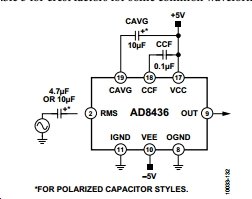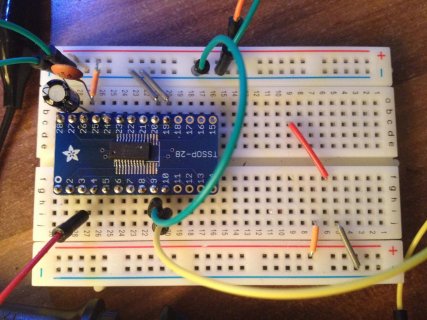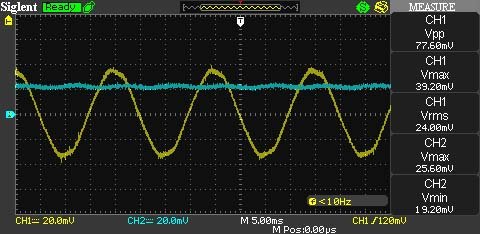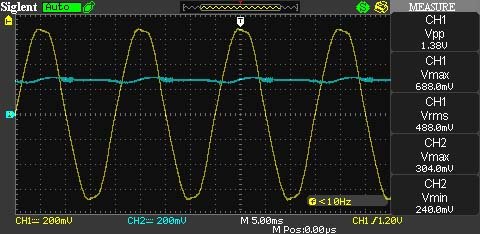You are using an out of date browser. It may not display this or other websites correctly.
You should upgrade or use an alternative browser.
You should upgrade or use an alternative browser.
Using External AREF with ADC
- Thread starter cocis
- Start date
- Status
- Not open for further replies.
AD8436 RMS-DC Converter [Ref #2/#3/#16]
JP My chips arrived and I have soldered one onto the breakout board.
I enclose a shot of the breadboard setup which reflects this simple circuit as per the datasheet. Note: In my case I am using a single, not dual supply.

Breadboard image:
When I connect in the signal source from the CT (3 different primary loads) I get the following readings for Channel 1 (Signal Source) To Channel 2 (AD8436 OUT Pin)
The Outpin is the yellow cable in the breadboard pic which is attached to scope channel 2 (The blue trace).
This doesn't look much like a DC signal to me. Also note how it begins to drift wildly from the scope RMS at higher primary input currents through the CT. Any ideas?



JP My chips arrived and I have soldered one onto the breakout board.
I enclose a shot of the breadboard setup which reflects this simple circuit as per the datasheet. Note: In my case I am using a single, not dual supply.

Breadboard image:

When I connect in the signal source from the CT (3 different primary loads) I get the following readings for Channel 1 (Signal Source) To Channel 2 (AD8436 OUT Pin)
The Outpin is the yellow cable in the breadboard pic which is attached to scope channel 2 (The blue trace).
This doesn't look much like a DC signal to me. Also note how it begins to drift wildly from the scope RMS at higher primary input currents through the CT. Any ideas?



Last edited:
Constantin
Well-known member
FWIW, if you're after 3-phase signals, the MCP3909 and other chips allow you to do that too. Simultaneous sampling across 6 channels (volts and current), etc. all in a package that from a pin layout perspective makes much more sense than the layout for pins they used in the MCP3010, MCP3901, MCP3911, etc.
neilh20
Well-known member
220V can be lethal - be careful
Hi, my take on measuring 220V is that if you are asking how to do it, you shouldn't do it. 220V can be lethal and requires special safety precautions as its lethal. Be careful! I have had some nefarious experience with 240V as a teenager, and I don't recommend it .
Its possible that there may be a"safe" way of measuring 220V by a clip on magnetic coil with and a proportional signal at 3.3V - but that still means potentially getting close to 220V - which as I mentioned which if you contact directly can be lethal.
I recently installed Neurio.io device in my switch box - and was very respectful of pushing and pulling wires around in it, and I've been amaze that it can measure a 60W lightbulb turning on.
Some people don't have a reasonable idea of unsafe practices with 240V http://www.bbc.co.uk/news/uk-39307418
I want to measure the voltage and current of 220V using MCP3911 2-channel analog input 3.3V. How measuring circuit for analog input of MCP3911? thank all
Hi, my take on measuring 220V is that if you are asking how to do it, you shouldn't do it. 220V can be lethal and requires special safety precautions as its lethal. Be careful! I have had some nefarious experience with 240V as a teenager, and I don't recommend it .
Its possible that there may be a"safe" way of measuring 220V by a clip on magnetic coil with and a proportional signal at 3.3V - but that still means potentially getting close to 220V - which as I mentioned which if you contact directly can be lethal.
I recently installed Neurio.io device in my switch box - and was very respectful of pushing and pulling wires around in it, and I've been amaze that it can measure a 60W lightbulb turning on.
Some people don't have a reasonable idea of unsafe practices with 240V http://www.bbc.co.uk/news/uk-39307418
- Status
- Not open for further replies.

